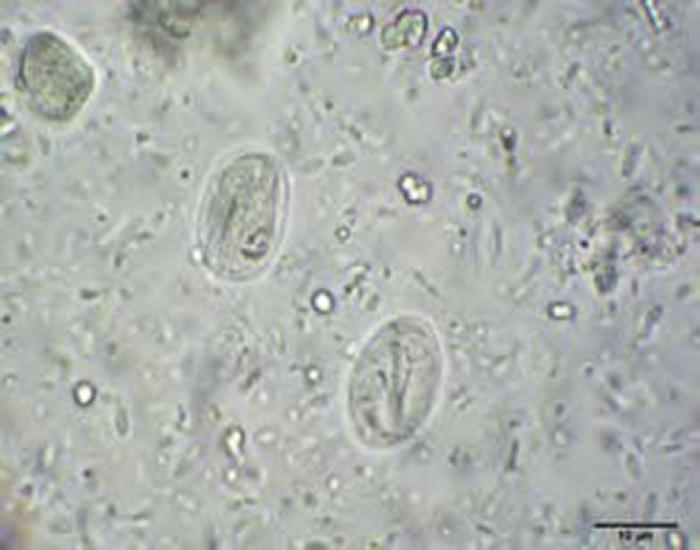Giardia
(Giardia duodenalis)
Giardia duodenalis is a common protozoana of dogs and a wide range of other hosts including cats, cattle, horses and humans. The primary route of infection is faecal-oral, either through direct, close contact or indirectly via contaminated food and water. Canine giardiasis is a potential zoonosis.
Distribution
Worldwide
Clinical signs
Giardia duodenalis infection is usually asymptomatic, except in young animals. When present, clinical signs include acute or chronic diarrhoea. Affected animals are usually alert and afebrile.
Diagnosis
Zinc sulfate centrifugal flotation (specific gravity 1.18) (SOP 2) is the test of choice for the visualization of Giardia cysts in faeces (Fig 1). Cysts are oval, 10-12 µm long and surrounded by a thin wall. In a diarrheic animal, a fresh faecal smear may reveal motile trophozoites, which have a typical ‘falling leaf’ motion; however faecal smears can be less sensitive than flotation.

Figure 1 Giardia cysts on faecal flotation. (Image credit: Dr. T. Inpankaew)
Rapid in-house commercial ELISA-based tests targeting antigens of Giardia in canine faeces are available. Alternatively, the sample can be sent to a commercial laboratory for PCR-based detection, where available.
Treatment
Febantel plus pyrantel and praziquantel given daily for 3 days, fenbendazole 50 mg/kg for 5 days and metronidazole 25 mg/kg twice daily for 5-7 days have proven efficacious in the treatment of Giardia.
Control
Pregnant females should be tested and treated, and dams bathed before whelping to remove cysts on the coat. Infected animals should be bathed, isolated and moved to a clean, disinfected enclosure once treated. If in a kennel situation, mass treat all animals at the same time. For further control options, refer to the General Considerations and Recommendations section.
Public health considerations
Dogs may harbour both dog-specific and zoonotic strains of Giardia that cannot be morphologically distinguished. All Giardia positive dogs must be suspected of carrying potentially zoonotic strains and owners must be advised on appropriate hygiene practices (see the General Considerations and Recommendations section) to minimize the risk of infection
